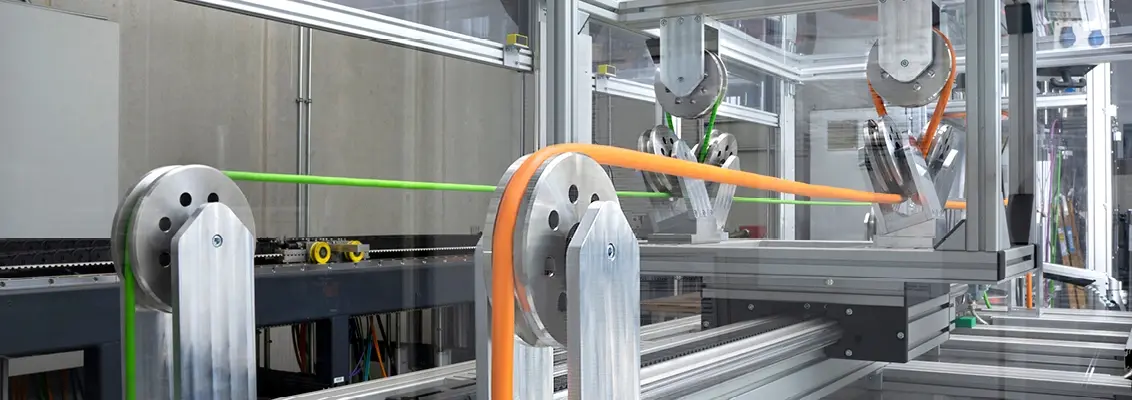Enhancing performance: High-Temperature cables for South Africa's toughest applications
The importance of high-temperature cables

Enhancing performance: High-Temperature cables for South Africa's toughest applications
South Africa is known for its diverse landscapes, from the Kalahari's arid deserts to the Drakensberg Mountains' lush vegetation. It's a nation with a thriving industrial and infrastructure sector that spans mining, manufacturing, energy production, and more. In these diverse and challenging environments, reliable and high-performance cables are paramount. HELUKABEL South Africa, a leading international manufacturer and supplier of cables, wires, and cable accessories, is a reliable partner for industry and infrastructure clients. This article will explore the critical role of high-temperature cables in South Africa's most demanding applications, the challenges they address, and how we are at the forefront of providing innovative solutions.The importance of high-temperature cablesHigh-temperature cables are vital in various industries and sectors across South Africa. They are designed to withstand extreme heat, making them essential for applications where standard cables would degrade or fail. Here are some key sectors where high-temperature cables are indispensable.• Mining: South Africa is known for its rich mineral resources, making mining a significant contributor to its economy. Mines are often located in harsh environments with elevated temperatures. High-temperature cables are used for various mining applications, including powering equipment and instrumentation.• Manufacturing: The manufacturing industry relies on precision and consistency in production processes. High-temperature cables are used in machinery, kilns, and furnaces, ensuring uninterrupted operations even under extreme heat conditions.• Energy generation: South Africa's energy landscape encompasses coal, nuclear, and renewable power generation. High-temperature cables are critical for transmitting electricity and managing heat generated during the process in power plants and substations.• Infrastructure development: Building bridges, tunnels, and transportation systems often involves working in high-temperature environments. These projects use high-temperature cables for lighting, control systems, and safety equipment.Challenges in South Africa's environmentsSouth Africa's climate varies widely, from scorching deserts to humid coastal areas. These diverse conditions pose unique challenges to cable infrastructure. Some of the challenges faced by cables operating in South Africa include:
• High temperatures: Many regions experience extremely high temperatures, especially during summer. Standard cables can become brittle and fail under such conditions.
• Corrosion: Coastal areas are prone to saltwater corrosion, which can deteriorate cables and insulation. Exposure to chemicals and abrasive materials can be equally damaging in mining environments.
• UV radiation: The strong African sun exposes outdoor cables to intense UV radiation, leading to degradation over time.
• Mechanical stress: Cables used in industries like mining and construction are subject to constant mechanical stress from heavy machinery and equipment.
• Electromagnetic interference (EMI): EMI is a common issue that can disrupt cable signals and affect data transmission and control systems in industrial settings.
HELUKABEL South Africa: Meeting the challenge
HELUKABEL South Africa understands the unique challenges faced by industries in the region. As a reliable partner for cable solutions, we offer various high-temperature cables designed to excel in South Africa's toughest applications.
• Heat resistance: Our high-temperature cables are engineered to withstand extreme heat, ensuring reliability in the harshest environments.
• Corrosion resistance: Specialised coatings and materials protect cables from corrosion caused by saltwater, chemicals, and abrasive substances.
• UV resistance: UV-resistant cable designs prevent degradation caused by prolonged exposure to the sun, making them suitable for outdoor applications.
• Mechanical durability: High-quality materials and robust construction ensure our cables can withstand the mechanical stress experienced in mining and construction environments.
• EMI shielding: We offer EMI-shielded cables designed to minimise electromagnetic interference, ensuring reliable data transmission and control systems.
Innovative cable solutions
Our commitment to innovation ensures we stay ahead in providing the best cable solutions for South Africa's demanding applications. Some of our innovative products include:
Silicone cables: Silicone-insulated cables are known for their exceptional heat resistance, flexibility, and durability. They are ideal for high-temperature applications in the manufacturing and energy sectors.
Mining cables: We offer specialised mining cables designed to withstand the harsh conditions of underground mining operations. These cables provide reliable power and data transmission for mining equipment.
Fire-resistant cables: In fire-prone areas, fire-resistant cables are essential for maintaining critical infrastructure. We offer fire-resistant cables that ensure continuous operation during fires.
Fibre optic cables: With the increasing demand for high-speed data transmission, we provide various fibre optic cables designed to meet the data communication needs of modern industries.
Contact HELUKABEL South Africa for details
Contact a representative from HELUKABEL, South Africa, today to know more about our offers on high-temperature cables. Alternatively, please continue browsing our website for additional information on our offers.
Ask the expert

Günter Meyer is head of dynamic testing at our factory in Windsbach.
What is the minimum bending radius and what does this value tell me?
The minimum bending radius is the smallest possible radius to which the cable can be bent without damaging it. It is specified as a multiple of the cable diameter. The smaller the value, the more flexible the cable. There are several industry standards defining the minimum bending radii for different cable types. The values differ greatly, depending on whether the cable is used in a fixed or moving application. A drag chain cable of type MULTIFLEX 512-C-PUR UL/CSA, for example, has a minimum bending radius of 4 x d in a fixed application, but only 7.5 x d in moving one. The reason for this is that the bending stress in a permanently moving cable is significantly higher as the force and the direction of the bending motion are constantly changing. A suitable minimum bending radius is hence an important criterion when choosing cables and wires.
How can the flexibility of a cable be improved?
There are various ways to improve this, starting with using the best materials. In most cases, copper wires comprising of fine or finest stranded conductors are sufficiently flexible. Alloys can be used as well for some bespoke applications. Care must be taken that the insulation and sheathing materials are likewise flexible. The choice of materials makes a big difference, especially in applications at extreme temperatures. PUR or TPE sheathing are suitable for cold temperatures as they don’t get very stiff. The diameter and construction also have a major impact on the cable’s bending properties. The shorter the lay length, i.e., tighter twisting inside the core stranding, the more flexible the cable.
